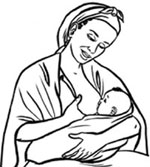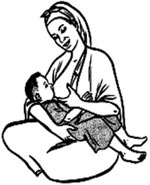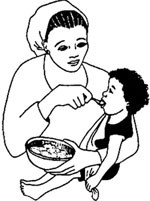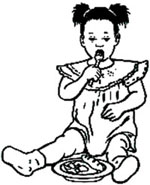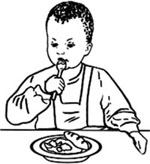Use 'Print preview' to check the number of pages and printer settings.
Print functionality varies between browsers.
Printable page generated Friday, 19 April 2024, 2:53 PM
Integrated Management of Newborn and Childhood Illness Module: 11. Infant and Young Child Feeding Recommendations
Study Session 11 Infant and Young Child Feeding Recommendations
Introduction
In the last study session you learned how to assess feeding problems, in particular in relation to breastfeeding, and how to support the mother so she can breastfeed her infant as effectively as possible. This study session looks at the feeding recommendations for infants and children in a range of age groups and teaches you how to counsel the mother on how to feed her child both during illness and when the child is well.
Learning Outcomes for Study Session 11
When you have studied this session, you should be able to:
11.1 Define and use correctly all of the key words printed in bold. (SAQs 11.1 and 11.2)
11.2 Recommend appropriate foods to give infants and children according to their ages. (SAQs 11.2 and 11.3)
11.3 Know the feeding recommendations for a mother who is HIV-positive. (SAQ 11.1)
11.4 Identify a range of feeding problems and solutions to them. (SAQ 11.3)
11.1 Feeding recommendations
When you are helping a mother with her infant’s feeding problems you should make sure that you give the appropriate advice for her child’s age and situation.
During illness, children may not want to eat much. However, they should be offered the types of food recommended for their age, as often as recommended, even though they may not take much at each meal. After illness, good feeding helps make up for weight loss, prevent malnutrition, and prevent future illness.
Your follow-up visits to a sick child are a good opportunity to counsel the mother on how to feed the child both during illness and when the child is well.
11.2 Recommendations for infants up to six months old
Table 11.1 sets out the feeding recommendations for infants from birth to six months old. It will remind you of some of the important points you covered in the last study session.
| Up to six months of age | ||
|---|---|---|
|
| The best way to feed a child from birth to at least six months of age is to breastfeed exclusively. Exclusive breastfeeding means that the child takes only breastmilk and no additional food, water, or other fluids (with the exception of medicines and vitamins, if needed). Advise the mother to empty one breast first before switching to the second to ensure the baby gets the nutrient-rich hind milk. |
11.2.1 Advantages of breastmilk
Promoting exclusive breastfeeding in infants up to six months old is important. As a Health Extension Practitioner you should encourage the mother to breastfeed her infant and not to give any other food or fluids in the first six months. You learned in Study Session 10 the different ways you can support a mother to breastfeed effectively. There are good reasons for promoting breastfeeding and these are outlined below.
Exclusive breastfeeding for the first six months will give an infant the best chance to grow and stay healthy.
Some of the advantages of breastmilk/breastfeeding
- Breastmilk contains the necessary nutrients needed by an infant
- The nutrients in breastmilk are easily absorbed
- It provides all the water an infant needs, even in a hot, dry climate
- It protects an infant against infection
- Breastfeeding helps maternal-infant bonding
- Breastfeeding helps in child spacing, and facilitates uterine contractions thereby reducing post-partum bleeding
- It may also reduce the mother’s risk of ovarian and breast cancers.
Some of the disadvantages of replacement (formula) feeding
- It reduces breastmilk production and intake
- It predisposes the infant to infections
- If dilute, replacement food will lead to malnutrition
- The infant may have difficulties digesting and absorbing nutrients from breastmilk substitutes
- Replacement food could lead to allergic diseases
- Replacement food could increase the risk of persistent diarrhoea.
How can a mother ensure the infant receives the nutrient-rich breastmilk?
You should advise the mother to empty the first breast before switching to the second, as this will ensure that the infant receives the hind milk.
Why should you advise the mother to exclusively breastfeed for the first six months?
Breastfeeding is the optimal way of feeding an infant in the first six months of life. Additionally it has a lot of health benefits for the mother. If the mother replaces breastmilk with other drinks or food, there are risks to the infant’s health.
11.3 Recommendations for infants from six to 12 months
You are now going to look at feeding and the range of foods appropriate for infants aged six‒12 months (see Table 11.2). As you will see, by six months, all children should have additional, nutritious food introduced into their diet, known as complementary foods.
| Six months up to 12 months | ||
|---|---|---|
|
| By six months of age, all children should be receiving a soft, nutritious complementary food. It is important to actively feed the child. Active feeding means encouraging the child to eat. The child should not have to compete with older brothers and sisters for food from a common plate. He should have his own serving. Until the child can feed himself, the mother or another caregiver (such as an older sibling, father or grandmother) should sit with the child during meals and help get the spoon into his mouth. An ‘adequate serving’ means that the child does not want any more food after active feeding. A good daily diet should be adequate in quantity and include an energy-rich food (for example, soft cereal-based porridge with added oil); meat, fish, eggs, or pulses; and fruits and vegetables. |
11.3.1 Good complementary foods
Good complementary foods are energy-rich, nutrient-rich and locally affordable. Examples in some areas are soft cereal-based porridge with added oil or milk, fruits, vegetables, pulses, meat, eggs, fish, and milk products. If the child receives cow’s milk or any other breastmilk substitute, these and any other drinks should be given by cup, not by bottle.
Examples of good complementary foods
The list below will help you to advise a mother of the kinds of nutritious foods she can prepare for her child.
- Mashed potatoes softened with milk, shiro fit-fit, merek fit-fit, and porridge made of cereal and legumes mixed with butter or oil added are nutrient-rich complementary foods to start in a child 6‒12 months of age. They are also recommended for a child 12 months up to two years.
- Porridge can be made from wheat, barley or teff with legumes added. Ask what cereals are available in the house. If it is feasible for her, advise the mother to make flour from several different grains plus peas. The consistency of the porridge should be thick enough to be fed by hand. When possible, use undiluted milk instead of water to prepare the porridge. Multi-mixes such as Fafa are very good if available. Kitta, softened in milk or prepared soft with oil or butter added, is another good alternative complementary food.
- Eggs provide good nutrition for infants and young children. They can be prepared by cooking or hard boiling. Tell the mother she can then break the egg up and feed it to the child or add it to the fit-fit. Egg can also be stirred into the porridge. Even if an egg can only be given once or a few times in a week it is very good for the child, especially if the child is malnourished.
Give a variety of thick, nutritious food for an infant over six months of age in addition to the breastfeeding.
Exclusive breastfeeding is not enough for a child over six months of age. A variety of thick, nutritious foods are needed to prevent malnutrition. You can advise the mother that she should also give mashed and boiled kale (gommen) and carrots, bananas, oranges and other fruits such as avocado or papaya to ensure her child has a healthy, balanced diet.
11.4 Recommendation for children from 12 months to two years
The table below (Table 11.3) sets out the appropriate types of foods for children from 12 months to two years. As you can see, the mother should continue breastfeeding if the child wants this, but additional foods should continue to be added to the child’s diet.
| 12 months up to two years | ||
|---|---|---|
|
| During this period the mother should continue to breastfeed as often as the child wants and also give nutritious complementary foods. The variety and quantity of food should be increased. Family foods should become an important part of the child’s diet. They should be appropriately prepared, so that they are easy for the child to eat. Give nutritious complementary foods or family foods five times a day. Adequate servings and active feeding (encouraging the child to eat) continue to be important. |
11.5 Recommendations for children aged two years and older
At this age, children should be eating a variety of foods in three meals a day, as well as two snacks during the day. The table below (Table 11.4) sets out the recommendations.
| Two years and older | ||
|---|---|---|
|
| At this age the child should be taking a variety of family foods in three meals per day. The child should also be given two extra feedings between meals (snacks) per day. These may be family foods or other nutritious foods which are convenient to give between meals. |
Examples of nutritional food include kitta (flat bread of non-fermented wheat flour) and dabo (home-made bread), softened with milk. These are good sources of protein and are energy-rich complementary foods for children over two years. In addition, consumption of potatoes and fruits, such as oranges and bananas, should be encouraged.
11.6 Feeding recommendations when a mother is HIV-positive
As you read earlier, breastfeeding has unsurpassed advantages over any other form of infant feeding. In resource-limited countries such as Ethiopia, breastfeeding is a key component of child survival interventions. Infant mortality is higher in settings where infants are not breastfed or breastfeed for a short time only (that is, less than six months).
Exclusive breastfeeding is the safest option for infants born to mothers who are HIV positive.
Although breastfeeding by an HIV-positive mother can transmit the virus to the infant, replacement feeding, if not instituted properly, is actually associated with increased risk of morbidity and mortality at a young age in low resource settings like Ethiopia. Exclusive breastfeeding (EBF) during the first six months of life is associated with decreased transmission of HIV and improved child survival compared with non-exclusive breastfeeding. Because of high infant mortality rates in Ethiopia, EBF for as long as possible up to six months is recommended as the only feasible and the safest option for infant feeding amongst HIV-infected women. At six months, complementary foods should be introduced in order to sustain normal growth. Most Ethiopian children will continue to benefit from breastfeeding until 12‒18 months of age. Universal access to antenatal and postnatal prevention of mother-to-child HIV transmission (PMTCT) services and prioritising antiretroviral therapy for eligible pregnant and lactating women is an important part of decreasing perinatal transmission of HIV.
The primary goals of infant feeding counselling and support are:
- Improve child survival by actively supporting exclusive breastfeeding for the first six months of life.
- Decrease HIV transmission via breastfeeding by treating pregnant and lactating HIV-infected women with low CD4 and advanced HIV disease.
- Provide antiretroviral prophylaxis to the mother or the infant to decrease HIV transmission.
CD4 refers to the type of white blood cells destroyed by HIV.
When the infant reaches six months, you should advise the mother to add complementary feeding in addition to the breastfeeding until the child reaches 12‒18 months. For examples of complementary foods, you can look back at the feeding recommendation in Section 11.3. Breastfeeding should stop only when a nutritionally adequate diet without breastmilk can be provided. This is usually around 12‒18 months of age. Infants who are known to be HIV-infected should continue to breastfeed according to recommendations for the general population.
What feeding advice will you give for an infant born from an HIV-positive mother if the infant is under six months old?
For infants under six months old you would advise the mother that she should breastfeed exclusively (only breastfeeding, not even water). If she or someone else in the family adds other foods or fluids this is known as mixed feeding, which will increase the chance of HIV transmission. For infants who are six months and above you would talk to the mother about complementary feeding and advise her that she should also continue breastfeeding.
11.7 Assess the child’s feeding
As a Health Extension Practitioner you will assess feeding of children who:
- are classified as having anaemia or very low weight for age, or
- are younger than two years old.
In some cases, you may find that you have already discussed with and given the mother advice on many other aspects of her infant’s health and provided several different treatment instructions. The mother may therefore be feeling overwhelmed and find it hard to take in more information at this stage. If you think this is the case, you may delay assessing feeding and counselling the mother about feeding until a later visit.
In Study Session 10 you learned how to assess breastfeeding. You will find more information about how to assess a child’s feeding if you look at page 40 of the Assess and Classify chart booklet. If you ask the questions set out there you will be able to find out about the child’s usual feeding and his feeding during his current illness. If you need to remind yourself of the kinds of questions to ask, go back to Study Session 10 and look at the guidance there.
Listen to any accounts of good feeding practices that the mother tells you about and praise her for the things she is doing well. It is important that you reinforce the positive things she is doing, as well as point out things that need to be changed. If an answer is unclear, ask another question. For example, if the mother of a very low weight child says that servings are ‘large enough,’ you could ask, ‘When the child has eaten, does he still want more?’ Working closely with the mother in this way, and helping her to provide optimum feeding for her child will help to promote the child’s healthy growth and development.
11.7.1 Identify feeding problems
You should complete the assessment of feeding and identify all the feeding problems before giving advice to the mother.
Based on the mother’s answers to your questions, you will be able to identify any differences between the recommendations for feeding and the child’s actual feeding. These differences are problems and you can see some examples of them listed in Table 11.5 below.
| CHILD’S ACTUAL FEEDING | RECOMMENDED FEEDING |
|---|---|
| A three-month-old is given sugar water as well as breastmilk. | A three-month-old should be given only breastmilk and no other food or fluid. |
| A two-year-old is fed only three times each day. | A two-year-old should receive two extra feedings between meals, as well as three meals a day. |
| An eight-month-old is still exclusively breastfed. | A breastfed eight-month-old should also be given adequate servings of a nutritious complementary food three times a day. |
| A seven-month-old is given gruel with a bottle. | A seven-month-old should be give soft porridge in addition to breastmilk. |
| A 12-month-old is given plain injera in addition to breastmilk. | A 12-month-old should receive adequate servings of nutritious foods in the form of fit-fit, porridge, with some oil or butter added. In addition he should be given fruit and vegetables. |
| A nine-month-old is not breastfed and is given one third strength cow’s milk. | A nine-month-old who is not breastfed should receive adequate servings of nutritious foods five times per day. |
Can you think of other feeding problems that you might encounter?
You might have thought about some of these examples:
- Use of a feeding bottle: feeding bottles should not be used because they transmit infection easily.
- Lack of active feeding: young children often need to be encouraged and assisted to eat.
- Relying on diluted milk or thin gruel (‘muk’) for nutrition: dilution makes food less energy and nutrient dense and therefore might lead to malnutrition. Remind the mother that thick foods which are dense in energy and nutrients are necessary for infants and young children to grow.
Other examples of feeding problems that you might have identified include the following:
Not feeding well during illness
During illness the child may be eating much less or eating different foods. Children often lose their appetite during illness. However, they should still be encouraged to eat the types of food recommended for their age, as often as recommended, even if they do not eat much. They should be offered their favourite nutritious foods, if possible, to encourage eating.
Not enough variety in the diet
The mother may mention that she gives one bulky food (such as maize porridge) to the child. One bulky food alone does not provide adequate nutrient intake. You should encourage her to give other varieties of food to enrich locally available staple foods.
Not giving the young child a share of meat, chicken or fish when this is eaten by the family
Young children often need to be given their own portions of the protein- and nutrient-rich family foods (such as meat, liver and chicken). Encourage mothers to provide such foods whenever they are available in the household.
Not giving gommen or other foods with vitamin A
Mothers should always be encouraged to provide gommen or other food items (such as liver and carrots) which are rich in vitamin A.
In the sick child registration book, next to the feeding questions, there is a box labelled ‘Feeding Problems’. You should use that space to record any feeding problem found and counsel the mother about these feeding problems, remembering to praise her for good practices and encouraging her (in a non-judgmental way) to adopt positive feeding approaches for her infant or child.
The chart in Table 11.6 below shows you how you should record feeding problems for a 4-month-old infant for whom a feeding assessment has been carried out.
| ASSESS CHILD’S FEEDING if child has ANAEMIA OR VERY LOW WEIGHT FOR AGE or is less than two years old | Feeding problems |
|---|---|
| Do you breastfeed your child? Yes ✓ No __ | |
| If Yes, how many times in 24 hours? 5 times. | Not breastfed often enough |
| Do you breastfeed during the night? Yes ✓ No__ | |
| Does the child take any other food or fluids? Yes ✓ No __ | Mixed Feeding |
| If Yes, what food or fluids? cow’s milk | Giving cow’s milk |
| How much is given at each feed? _____________________ | |
| How many times in 24 hours? ______ times. | |
| What do you use to feed the child? Cup___ Bottle ✓ Other_______ | Using feeding bottle |
| |
| |
| Failed to increase feeding to help aid recovery |
A feeding assessment should be done for all children who are less than two years old and for those who are classified as having anaemia or very low weight for age. If you find any feeding problems you should counsel the mother or the caregivers on the recommended feeding that corresponds to the child’s age. The tables with feeding recommendations, set out in this study session, provide useful guidance if you need to remind yourself about the different foods appropriate at different times in the child’s life.
In this study session, you have learned recommended feeding for infants and children according to their age. You have seen that complementary foods should be varied and energy rich, to promote growth and development of the child. The study session also stressed the importance of exclusive breastfeeding for infants of HIV-positive mothers. Additionally you have looked at how to assess and identify feeding problems, counselling and supporting the mother on recommended feeding practices, and how to record problems in the sick child registration book.
Summary of Study Session 11
In Study Session 11, you have learned that:
- There are different feeding recommendations for children according to their age.
- Infants born to HIV-positive mothers should be exclusively breastfed for six months and then given complementary foods as well as breastmilk.
- There are some common feeding problems in infants and children, and with some simple support and advice from you, mothers can usually overcome these difficulties.
Self-Assessment Questions (SAQs) for Study Session 11
Now that you have completed this study session, you can assess how well you have achieved its Learning Outcomes by answering these questions. Write your answers in your Study Diary and discuss them with your Tutor at the next Study Support Meeting. You can check your answers with the Notes on the Self-Assessment Questions at the end of this Module.
SAQ 11.1 (tests Learning Outcomes 11.1 and 11.3)
How should the way a child is fed change as he or she grows older? (Think about the kinds of foods a child will have, how much he will eat and also how he will eat.)
Answer
A baby up to six months old should if possible be breastfed exclusively. After six months breastfeeding may gradually stop and the child given replacement milk; or breastfeeding may continue up to the age of the two years if the child wants it.
After six months, a child should be given additional complementary foods. These should be semi-solid. But as the child gets older, he can start to eat the same as the rest of the family.
After six months the child should be encouraged to eat, at first with the help of other members of the family and, as he grows older, by himself. He should always have his own serving.
From breastfeeding at least eight times in 24 hours the infant will change to feeding five times a day; then by the age of two he needs just three main meals a day with snacks in between.
SAQ 11.2 (tests Learning Outcomes 11.1 and 11.2)
Are the feeding recommendations for a mother who is HIV-positive the same as for a mother who does not have HIV? Give reasons for your answer.
Answer
It is very similar except that there is even more emphasis on exclusive breastfeeding up to the age of six months if the mother has HIV. Also, the breastfeeding should continue if possible until 12–18 months alongside complementary feeding.
SAQ 11.3 (tests Learning Outcomes 11.2 and 11.4)
How would you go about assessing the way a mother breastfeeds? What kind of help might you be able to give the mother after your assessment?
Answer
You should first find out from the mother whether she thinks there are any problems and also ask her about frequency of feeding and whether the baby has any other foods .Then you need to observe her feeding the baby, for at least four minutes. This means looking at the position of the baby, how it attaches, and how it sucks. There should also be examination of the baby for white patches in the mouth.
The main help you can give the mother will be to give her advice about excusive and frequent breastfeeding. You can also help by teaching her the correct position for feeding so that the baby attaches well.
